Abstract
Natural isolates of Escherichia coli, Salmonella typhimurium, Klebsiella pneumoniae, and Providencia stuartii were analysed to determine their plasmid content. This data allowed the identification of nosocomial strains of K. pneumoniae and P. stuartii and helped in the differentiation of epidemic strains of E. coli 0111 and S. typhimurium. Phenotypically similar isolates of S. typhimurium could be shown to be of independent origin using plasmid pattern analysis. The dissemination of a particular plasmid through different strains of S. typhimurium resulted in a simulation of a very widely distributed epidemic strain, because the plasmid interfered with the phage type of its host strain in addition to determining resistance properties. Plasmid pattern analysis disclosed two independently existing but interacting epidemic processes: a bacterial 'epidemic' strain may become disseminated over a large territory and may predominate there for a long time; a single plasmid, however, may also become distributed through many different bacterial strains and may spread over a large territory. Plasmid pattern analysis provides a valuable and universal epidemiological laboratory method.
Full text
PDF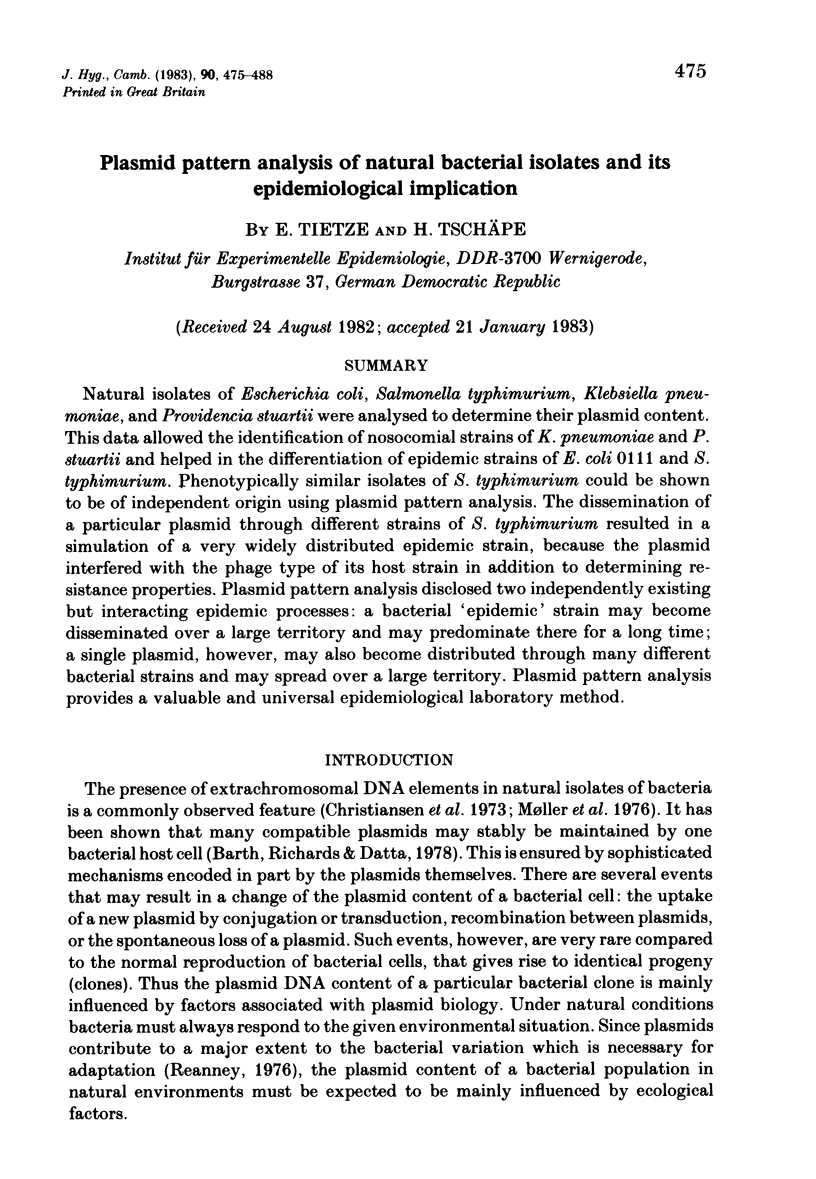
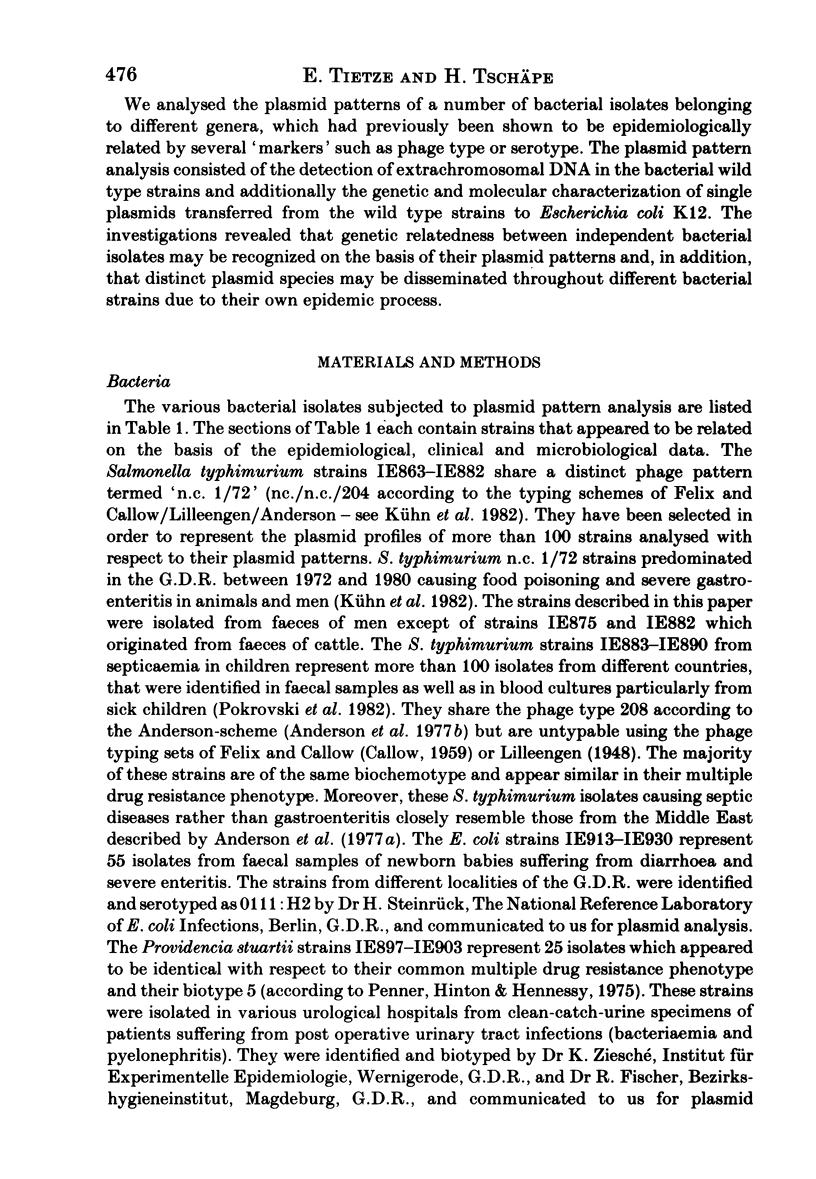
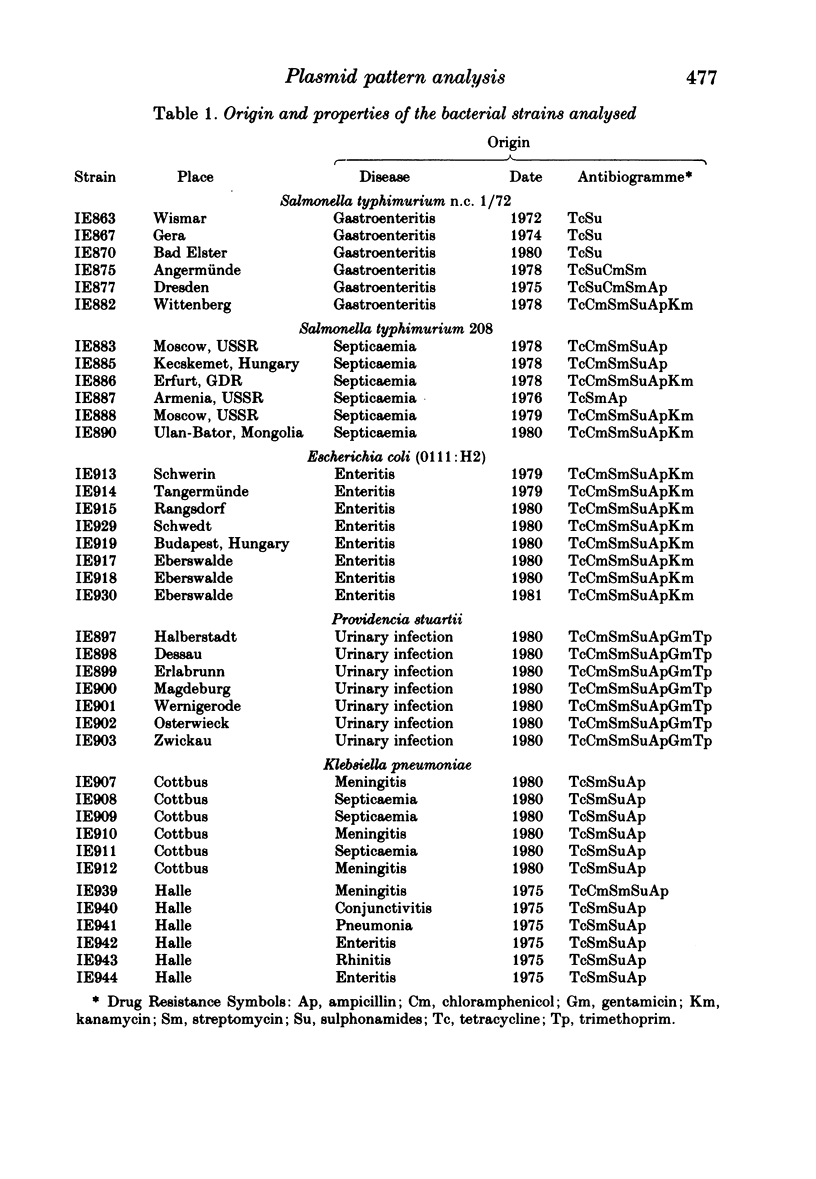
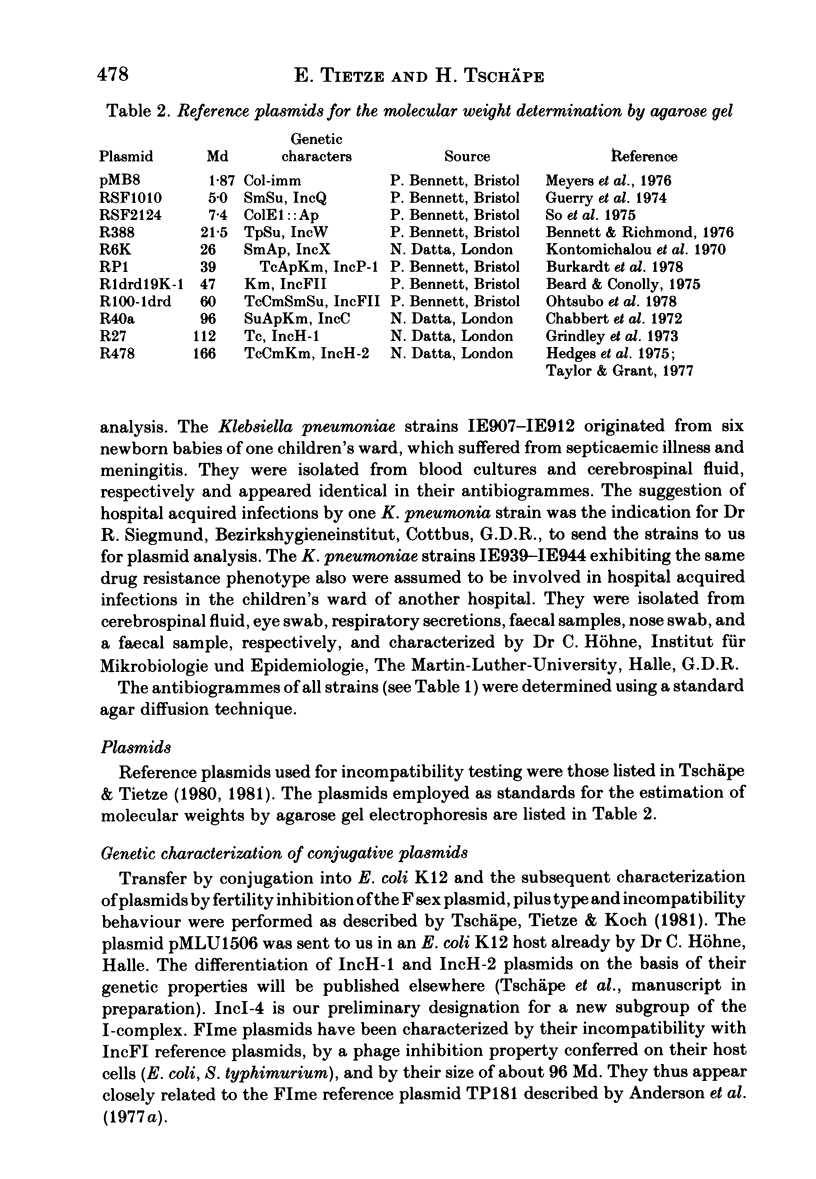
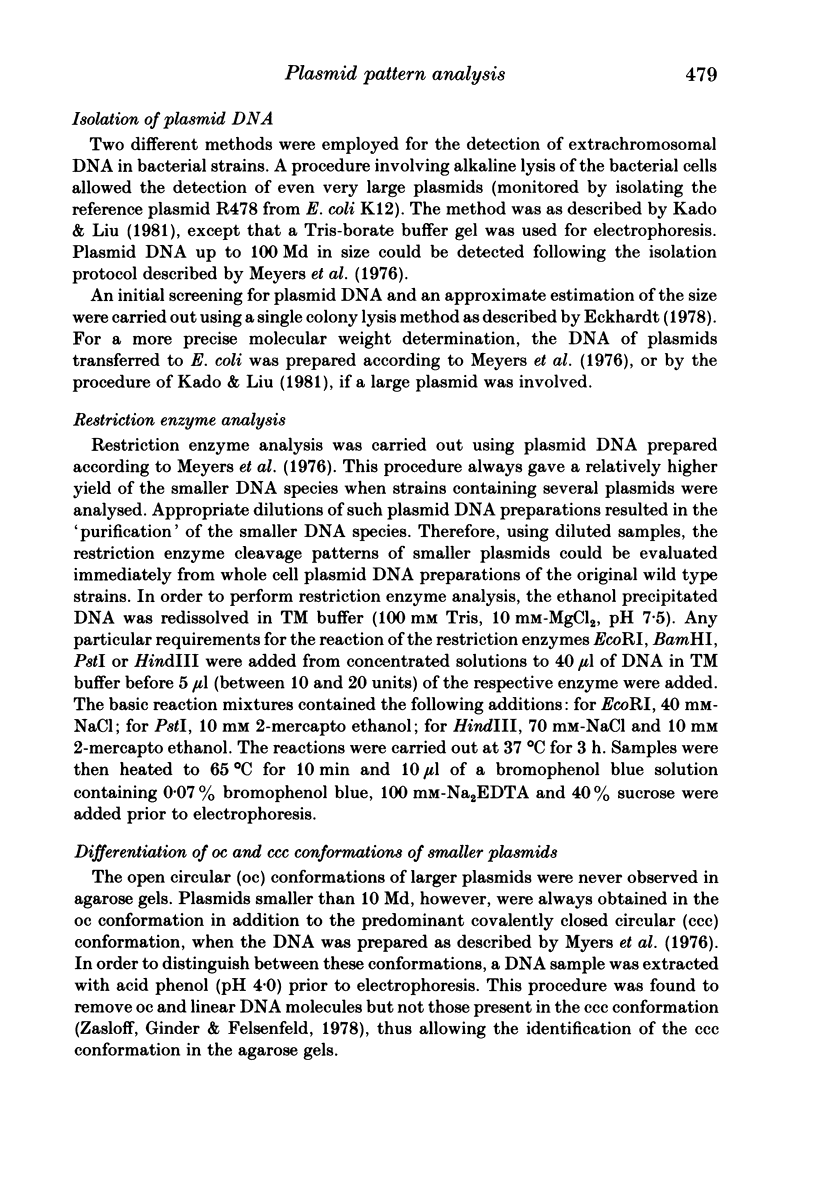
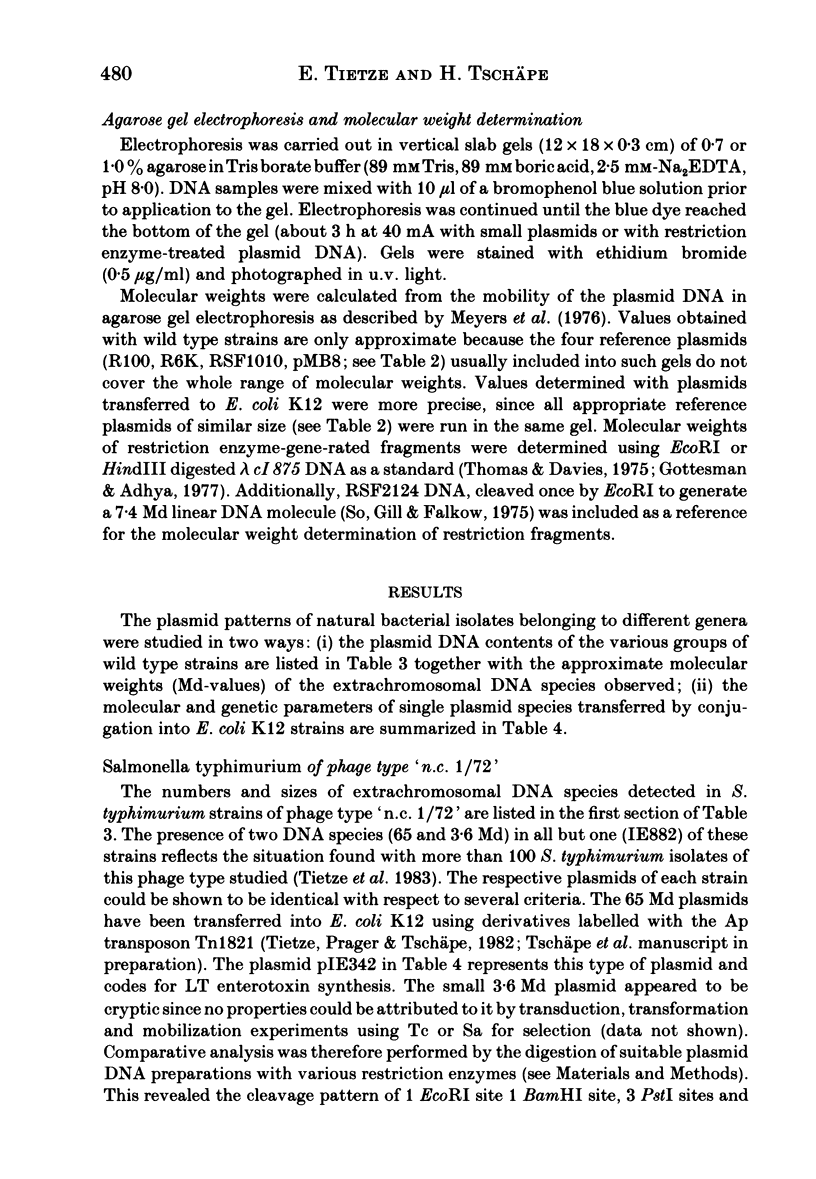
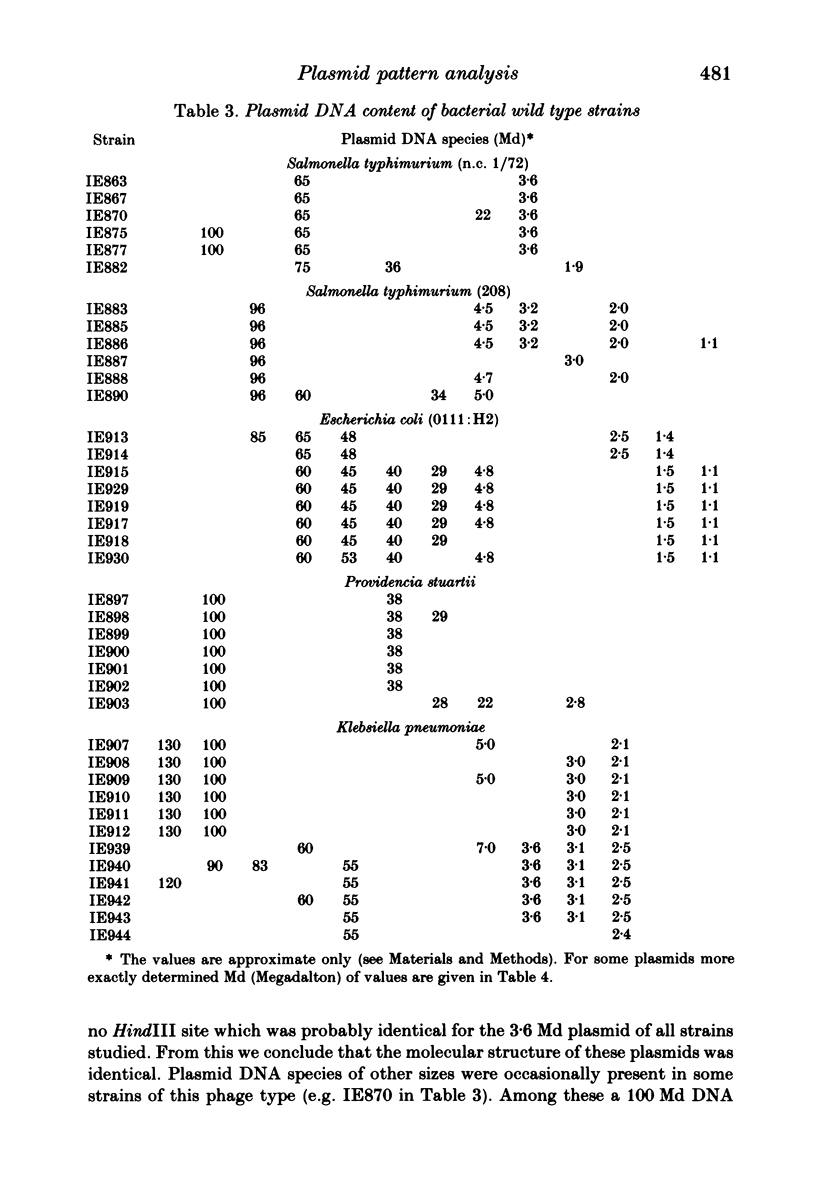
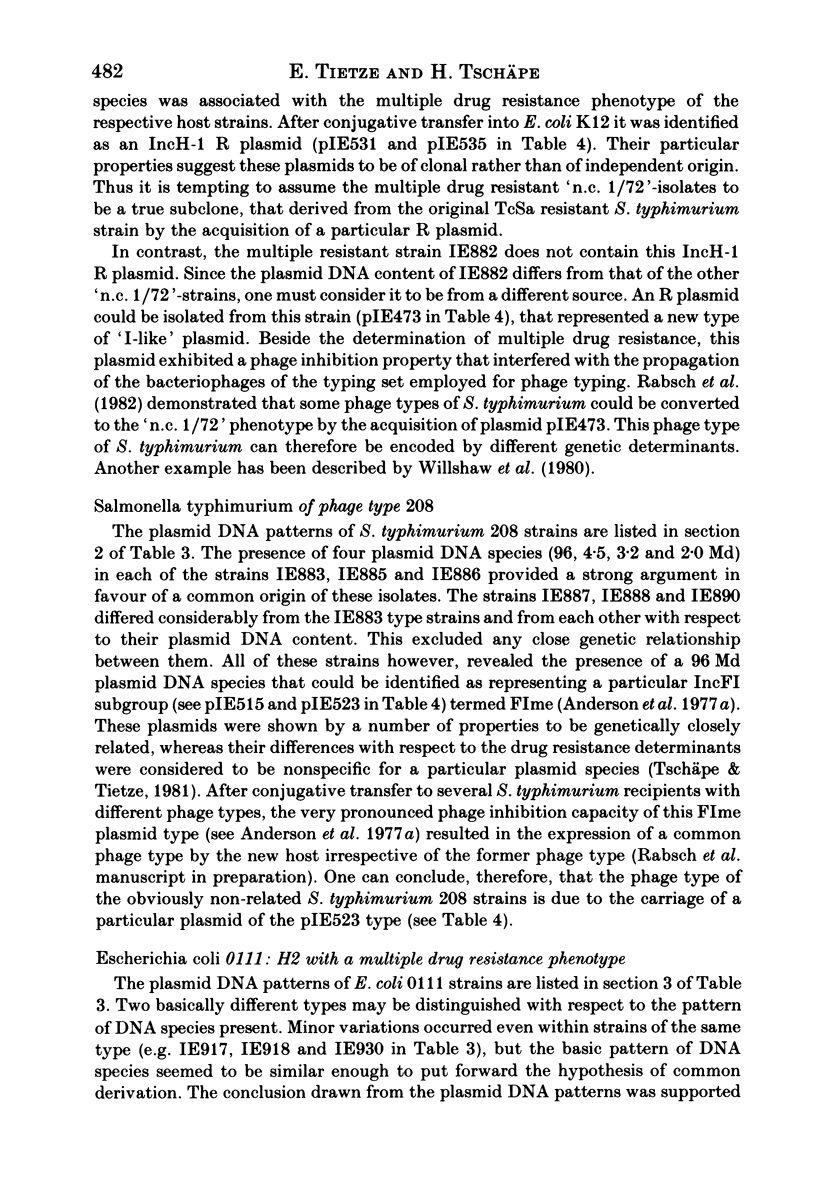
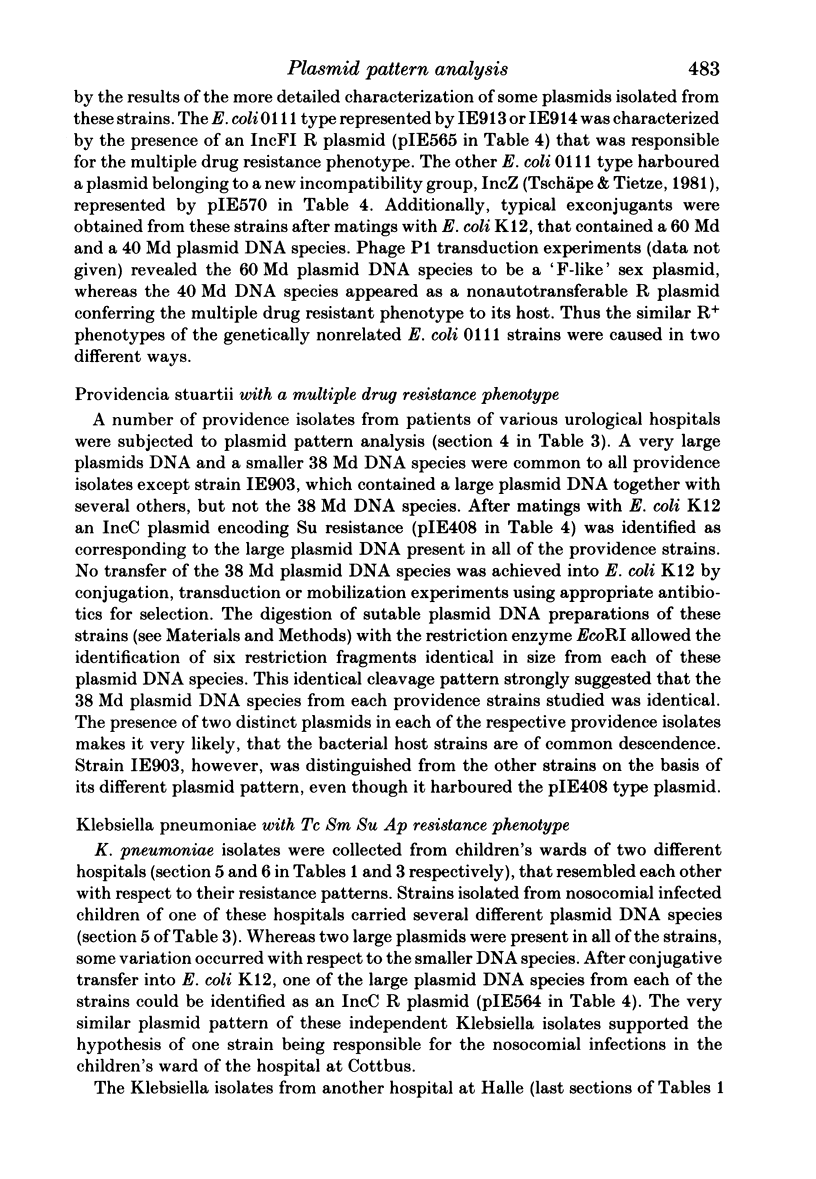
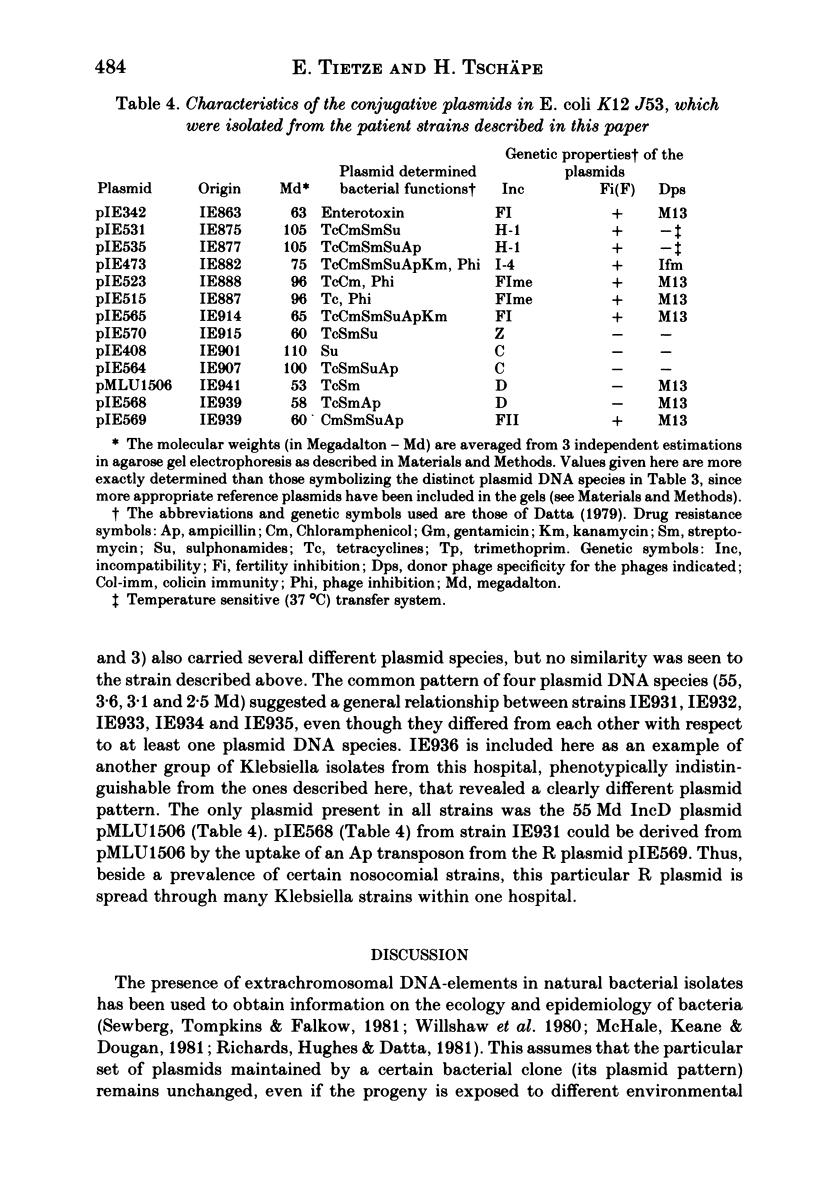
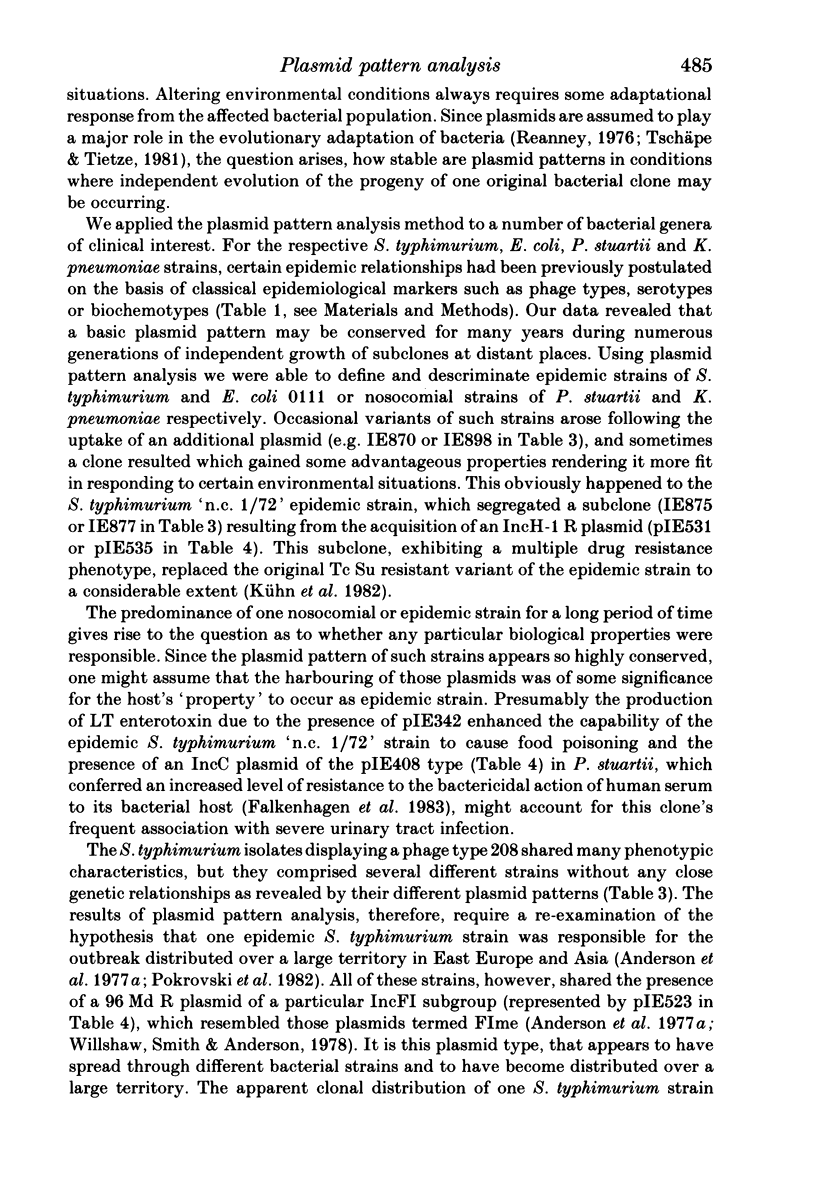
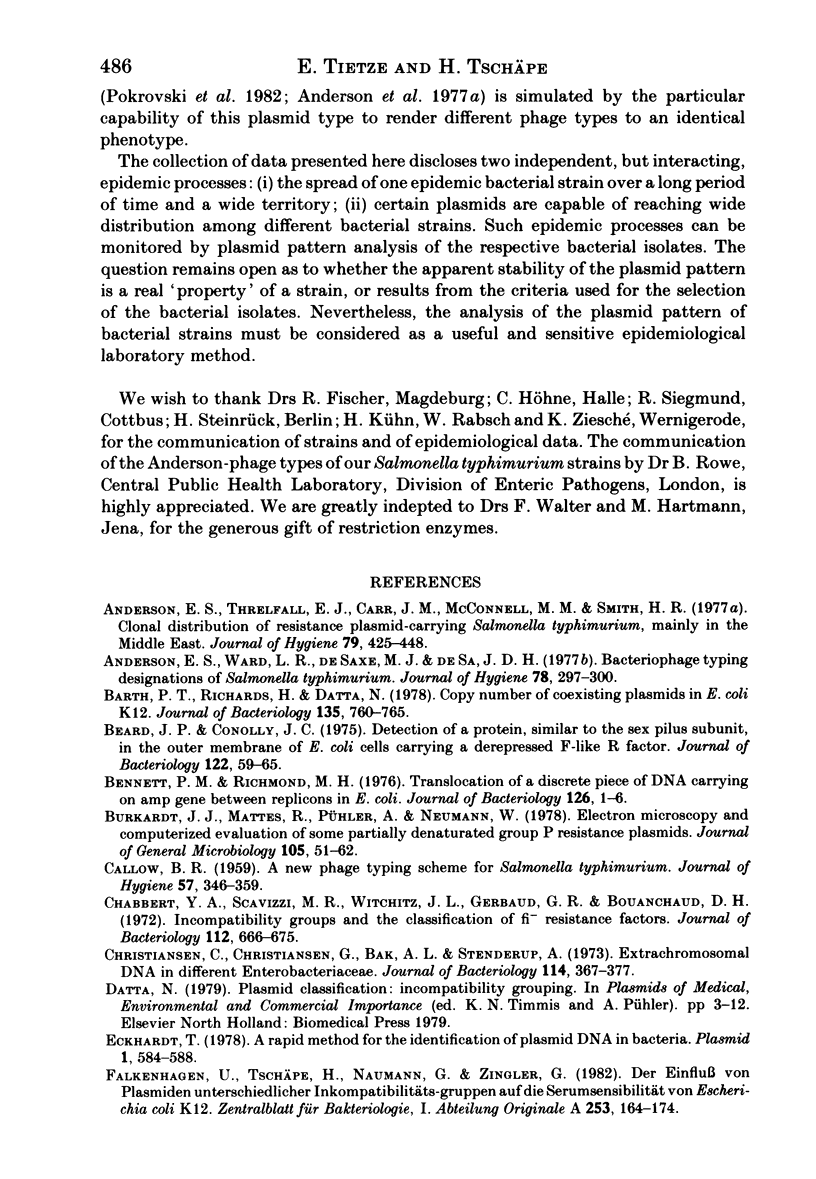
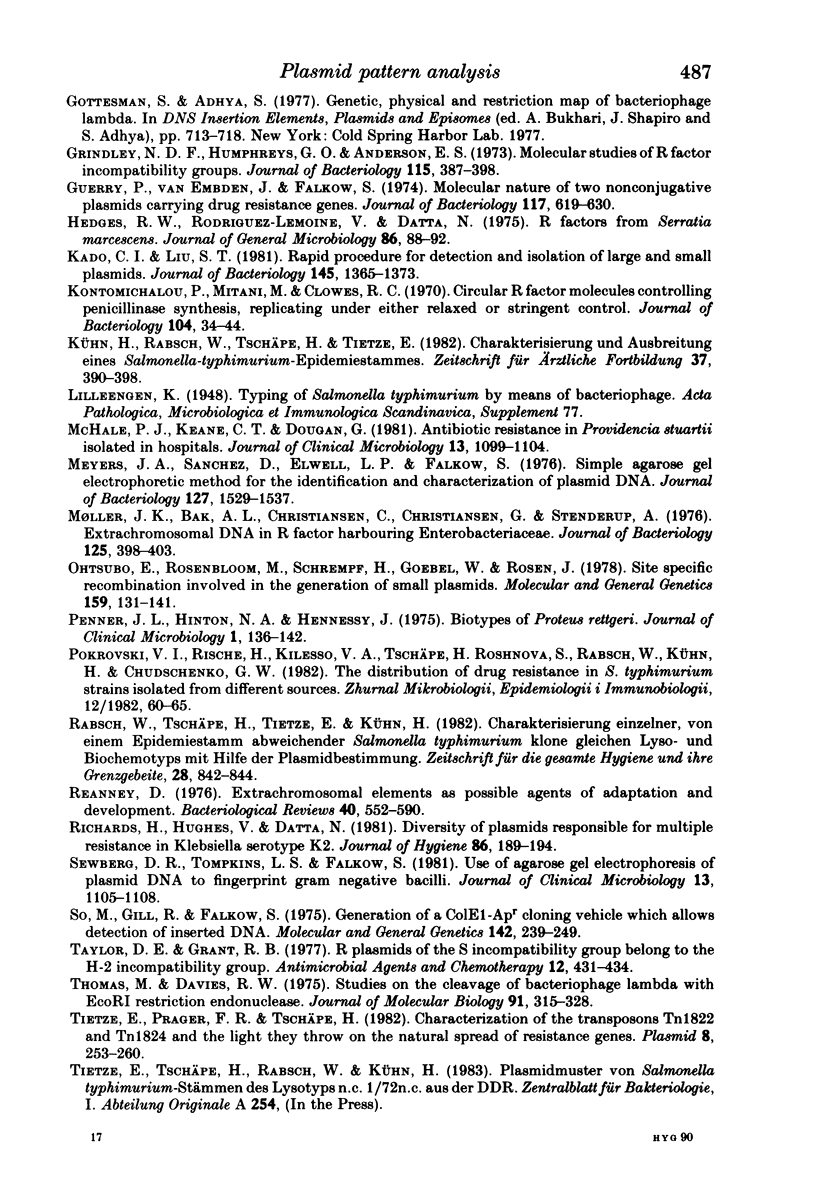
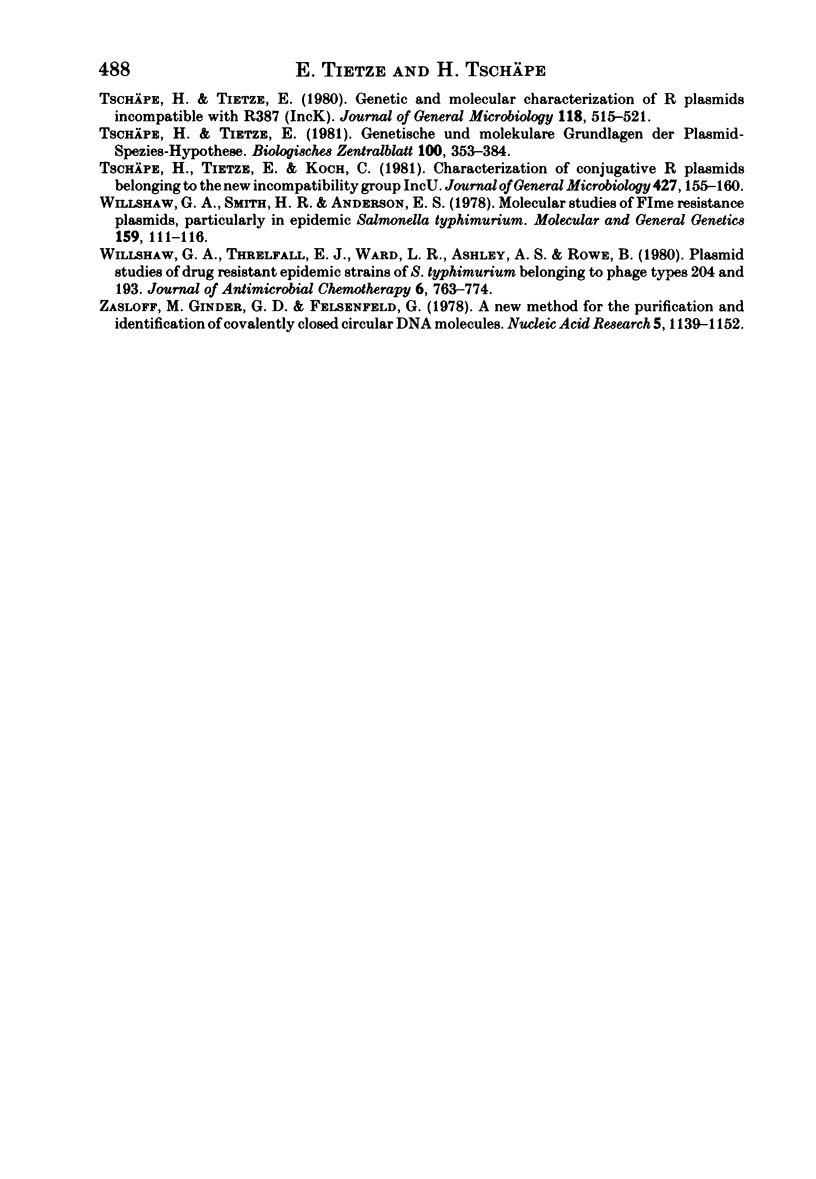
Selected References
These references are in PubMed. This may not be the complete list of references from this article.
- Anderson E. S., Threlfall E. J., Carr J. M., McConnell M. M., Smith H. R. Clonal distribution of resistance plasmid-carrying Salmonella typhimurium, mainly in the Middle East. J Hyg (Lond) 1977 Dec;79(3):425–448. doi: 10.1017/s0022172400053286. [DOI] [PMC free article] [PubMed] [Google Scholar]
- Anderson E. S., Ward L. R., Saxe M. J., de Sa J. D. Bacteriophage-typing designations of Salmonella typhimurium. J Hyg (Lond) 1977 Apr;78(2):297–300. doi: 10.1017/s0022172400056187. [DOI] [PMC free article] [PubMed] [Google Scholar]
- Barth P. T., Richards H., Datta N. Copy numbers of coexisting plasmids in Escherichia coli K-12. J Bacteriol. 1978 Sep;135(3):760–765. doi: 10.1128/jb.135.3.760-765.1978. [DOI] [PMC free article] [PubMed] [Google Scholar]
- Beard J. P., Connolly J. C. Detection of a protein, similar to the sex pilus subunit, in the outer membrane of Escherichia coli cells carrying a derepressed F-like R factor. J Bacteriol. 1975 Apr;122(1):59–65. doi: 10.1128/jb.122.1.59-65.1975. [DOI] [PMC free article] [PubMed] [Google Scholar]
- Bennett P. M., Richmond M. H. Translocation of a discrete piece of deoxyribonucleic acid carrying an amp gene between replicons in Eschericha coli. J Bacteriol. 1976 Apr;126(1):1–6. doi: 10.1128/jb.126.1.1-6.1976. [DOI] [PMC free article] [PubMed] [Google Scholar]
- Burkardt H. J., Mattes R., Pühler A., Heumann W. Electron microscopy and computerized evaluation of some partially denatured group P resistance plasmids. J Gen Microbiol. 1978 Mar;105(1):51–62. doi: 10.1099/00221287-105-1-51. [DOI] [PubMed] [Google Scholar]
- CALLOW B. R. A new phage-typing scheme for Salmonella typhi-murium. J Hyg (Lond) 1959 Sep;57:346–359. doi: 10.1017/s0022172400020209. [DOI] [PMC free article] [PubMed] [Google Scholar]
- Chabbert Y. A., Scavizzi M. R., Witchitz J. L., Gerbaud G. R., Bouanchaud D. H. Incompatibility groups and the classification of fi - resistance factors. J Bacteriol. 1972 Nov;112(2):666–675. doi: 10.1128/jb.112.2.666-675.1972. [DOI] [PMC free article] [PubMed] [Google Scholar]
- Christiansen C., Christiansen G., Bak A. L., Stenderup A. Extrachromosomal deoxyribonucleic acid in different enterobacteria. J Bacteriol. 1973 Apr;114(1):367–377. doi: 10.1128/jb.114.1.367-377.1973. [DOI] [PMC free article] [PubMed] [Google Scholar]
- Eckhardt T. A rapid method for the identification of plasmid desoxyribonucleic acid in bacteria. Plasmid. 1978 Sep;1(4):584–588. doi: 10.1016/0147-619x(78)90016-1. [DOI] [PubMed] [Google Scholar]
- Falkenhagen U., Tschäpe H., Naumann G., Zingler G. Der Einfluss von Plasmiden unterschiedlicher Inkompatibilitätsgruppen auf die Serumsensibilität von Escherichia coli K12. Zentralbl Bakteriol Mikrobiol Hyg A. 1982 Nov;253(2):164–174. [PubMed] [Google Scholar]
- Grindley N. D., Humphreys G. O., Anderson E. S. Molecular studies of R factor compatibility groups. J Bacteriol. 1973 Jul;115(1):387–398. doi: 10.1128/jb.115.1.387-398.1973. [DOI] [PMC free article] [PubMed] [Google Scholar]
- Guerry P., van Embden J., Falkow S. Molecular nature of two nonconjugative plasmids carrying drug resistance genes. J Bacteriol. 1974 Feb;117(2):619–630. doi: 10.1128/jb.117.2.619-630.1974. [DOI] [PMC free article] [PubMed] [Google Scholar]
- Hedges R. W., Rodriguez-Lemoine V., Datta N. R factors from Serratia marcescens. J Gen Microbiol. 1975 Jan;86(1):88–92. doi: 10.1099/00221287-86-1-88. [DOI] [PubMed] [Google Scholar]
- Kado C. I., Liu S. T. Rapid procedure for detection and isolation of large and small plasmids. J Bacteriol. 1981 Mar;145(3):1365–1373. doi: 10.1128/jb.145.3.1365-1373.1981. [DOI] [PMC free article] [PubMed] [Google Scholar]
- Kontomichalou P., Mitani M., Clowes R. C. Circular R-factor molecules controlling penicillinase synthesis, replicating in Escherichia coli under either relaxed or stringent control. J Bacteriol. 1970 Oct;104(1):34–44. doi: 10.1128/jb.104.1.34-44.1970. [DOI] [PMC free article] [PubMed] [Google Scholar]
- McHale P. J., Keane C. T., Dougan G. Antibiotic resistance in Providencia stuartii isolated in hospitals. J Clin Microbiol. 1981 Jun;13(6):1099–1104. doi: 10.1128/jcm.13.6.1099-1104.1981. [DOI] [PMC free article] [PubMed] [Google Scholar]
- Meyers J. A., Sanchez D., Elwell L. P., Falkow S. Simple agarose gel electrophoretic method for the identification and characterization of plasmid deoxyribonucleic acid. J Bacteriol. 1976 Sep;127(3):1529–1537. doi: 10.1128/jb.127.3.1529-1537.1976. [DOI] [PMC free article] [PubMed] [Google Scholar]
- Moller J. K., Bak A. L., Christiansen C., Christiansen G., Stenderup A. Extrachromosomal deoxyribonucleic acid in R factor-harboring Enterobacteriaceae. J Bacteriol. 1976 Feb;125(2):398–403. doi: 10.1128/jb.125.2.398-403.1976. [DOI] [PMC free article] [PubMed] [Google Scholar]
- Ohtsubo E., Rosenbloom M., Schrempf H., Goebel W., Rosen J. Site specific recombination involved in the generation of small plasmids. Mol Gen Genet. 1978 Feb 16;159(2):131–141. doi: 10.1007/BF00270886. [DOI] [PubMed] [Google Scholar]
- Penner J. L., Hinton N. A., Hennessy J. Biotypes of Proteus rettgeri. J Clin Microbiol. 1975 Feb;1(2):136–142. doi: 10.1128/jcm.1.2.136-142.1975. [DOI] [PMC free article] [PubMed] [Google Scholar]
- Pokrovskii V. I., Rische H., Kilesso V. A., Tschäpe H., Rozhnova S. Sh. Rasprostranenie ustoichivosti k antibiotikam u shtammov Salmonella typhimurium, vydellennykh pri razlichnykh épidemicheskikh situatsiiakh. Zh Mikrobiol Epidemiol Immunobiol. 1982 Dec;(12):60–65. [PubMed] [Google Scholar]
- Rabsch W., Tschäpe H., Tietze E., Kühn H. Charakterisierung einzelner von einem Epidemiestamm abweichender Salmonella typhimurium Klone gleichen Lyso- und Biochemotyps mit Hilfe der Plasmidbestimmung. Z Gesamte Hyg. 1982 Dec 12;28(12):842–844. [PubMed] [Google Scholar]
- Reanney D. Extrachromosomal elements as possible agents of adaptation and development. Bacteriol Rev. 1976 Sep;40(3):552–590. doi: 10.1128/br.40.3.552-590.1976. [DOI] [PMC free article] [PubMed] [Google Scholar]
- Richards H., Hughes V., Datta N. Diversity of plasmids responsible for multiple resistance in Klebsiella serotype K2. J Hyg (Lond) 1981 Apr;86(2):189–194. doi: 10.1017/s002217240006890x. [DOI] [PMC free article] [PubMed] [Google Scholar]
- Schaberg D. R., Tompkins L. S., Falkow S. Use of agarose gel electrophoresis of plasmid deoxyribonucleic acid to fingerprint gram-negative bacilli. J Clin Microbiol. 1981 Jun;13(6):1105–1108. doi: 10.1128/jcm.13.6.1105-1108.1981. [DOI] [PMC free article] [PubMed] [Google Scholar]
- So M., Gill R., Falkow S. The generation of a ColE1-Apr cloning vehicle which allows detection of inserted DNA. Mol Gen Genet. 1975 Dec 30;142(3):239–249. doi: 10.1007/BF00425649. [DOI] [PubMed] [Google Scholar]
- Taylor D. E., Grant R. B. R plasmids of the S incompatibility group belong to the H2 incompatibility group. Antimicrob Agents Chemother. 1977 Sep;12(3):431–434. doi: 10.1128/aac.12.3.431. [DOI] [PMC free article] [PubMed] [Google Scholar]
- Thomas M., Davis R. W. Studies on the cleavage of bacteriophage lambda DNA with EcoRI Restriction endonuclease. J Mol Biol. 1975 Jan 25;91(3):315–328. doi: 10.1016/0022-2836(75)90383-6. [DOI] [PubMed] [Google Scholar]
- Tietze E., Prager R., Tschäpe H. Characterization of the transposons Tn1822 (Tc) and Tn1824 (TpSm) and the light they throw on the natural spread of resistance genes. Plasmid. 1982 Nov;8(3):253–260. doi: 10.1016/0147-619x(82)90063-4. [DOI] [PubMed] [Google Scholar]
- Tschäpe H., Tietze E. Genetic and molecular characterization of R plasmids incompatible with R387 (IncK). J Gen Microbiol. 1980 Jun;118(2):515–521. doi: 10.1099/00221287-118-2-515. [DOI] [PubMed] [Google Scholar]
- Tschäpe H., Tietze E., Koch C. Characterization of conjugative R plasmids belonging to the new incompatibility group IncU. J Gen Microbiol. 1981 Nov;127(1):155–160. doi: 10.1099/00221287-127-1-155. [DOI] [PubMed] [Google Scholar]
- Willshaw G. A., Smith H. R., Anderson E. S. Molecular studies of FIme resistance plasmids, particularly in epidemic Salmonella typhimurium. Mol Gen Genet. 1978 Feb 7;159(1):111–116. doi: 10.1007/BF00401755. [DOI] [PubMed] [Google Scholar]
- Willshaw G. A., Threlfall E. J., Ward L. R., Ashley A. S., Rowe B. Plasmid studies of drug-resistant epidemic strains of Salmonella typhimurium belonging to phage types 204 and 193. J Antimicrob Chemother. 1980 Nov;6(6):763–773. doi: 10.1093/jac/6.6.763. [DOI] [PubMed] [Google Scholar]
- Zasloff M., Ginder G. D., Felsenfeld G. A new method for the purification and identification of covalently closed circular DNA molcules. Nucleic Acids Res. 1978 Apr;5(4):1139–1152. doi: 10.1093/nar/5.4.1139. [DOI] [PMC free article] [PubMed] [Google Scholar]


